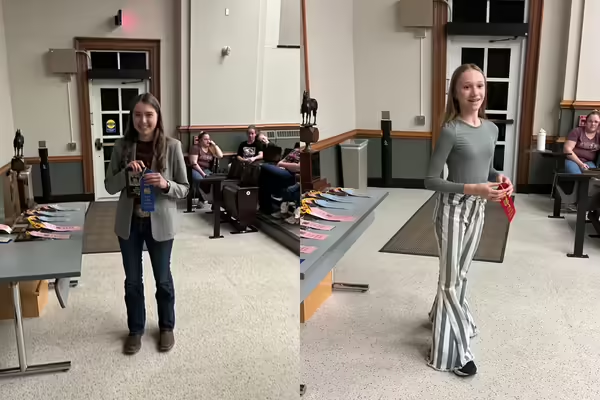
Urbana, Ill. – The Illinois 4-H Horse Speaking contest helps youth gain self-confidence, courage and persuasiveness; share ideas with others; and develop the ability to speak in public to inform others about horse-related subjects and the 4-H Horse project. This year’s contest was held April 11-12 on the University of Illinois campus.
Youth compete in one of five divisions, and All presentation subjects must pertain to the horse industry, or be horse related, and be original and factual. Presentations cannot involve the use of live animals; however, model animals may be used.
In Original individual formal speech youth share a prepared formal speech on a horse-related topic.
In Senior Formal Speech, Stephanie Niesen of DeWitt County took first place.
In Junior Formal Speech, Mallory Paur of Madison County took first place.
In Original individual presentation youth may use either demonstration or illustrated talk on an idea or topic and may use visual aids.
In Senior Individual Presentation, Allison Burrs of Carroll County took first place.
In Junior Individual Presentation, Paisley Martin of Mercer County took first place.
In Original presentation team, teams use either demonstration or illustrated talk on an idea or topic and may use visual aids.
In the Team Presentation Senior Division, Allison Burrs of Carroll County and Hannah Wenzel of Saline County took first place.
In the Team Presentation Junior Division, Paisley Martin and Brooklynne Martin of Mercer County took first place.
In Extempore speaking, a topic is selected at the event and participants have 25 minutes to prepare a four-to-six minute speech.
In Senior Extemporaneous, Hannah Wenzel of Saline County took first place.
In Junior Extemporaneous, Nora Moore of Madison County took first place.
In Interpretive Reading youth use the art of reading aloud from a printed page. Youth may choose prose, poetry, short stories, play cuttings, narratives, book or review, or theatrical that is horse-related.
In Interpretative Reading, Paisley Martin of Mercer County took first place.
About Illinois 4-H:
Illinois 4-H is the flagship youth development program of University of Illinois Extension, administered through the College of Agricultural, Consumer and Environmental Sciences. Through hands-on learning and life-changing experiences, Illinois 4-H prepares youth to be Beyond Ready — ready for college, career, military service, entrepreneurship, and more. Young people build confidence, leadership, and resilience as they explore interests from agriculture to computer science. Independent research and national surveys confirm the powerful outcomes of 4-H: participants are 40% more likely to pursue a college degree, twice as likely to obtain technical training, and two times more likely to serve in the military. With a legacy of cultivating leaders, Illinois 4-H continues to grow the next generation who are equipped to thrive in life and work today and beyond.
For Further Information, Contact:
Source: Deb Hagstrom, University of Illinois Extension Specialist, Horses hagstrom@illinois.edu
Writer: Carissa Nelson, Media Communications Manager, 4-H State Office, carissa@illinois.edu
University of Illinois Extension develops educational programs, extends knowledge, and builds partnerships to support people, communities, and their environments as part of the state's land-grant institution. Extension serves as the leading public outreach effort for University of Illinois Urbana-Champaign and the College of Agricultural, Consumer and Environmental Sciences in all 102 Illinois counties through a network of 27 multi-county units and over 700 staff statewide. Extension’s mission is responsive to eight strategic priorities — community, economy, environment, food and agriculture, health, partnerships, technology and discovery, and workforce excellence — that are served through six program areas — 4-H youth development, agriculture and agribusiness, community and economic development, family and consumer science, integrated health disparities, and natural resources, environment, and energy.